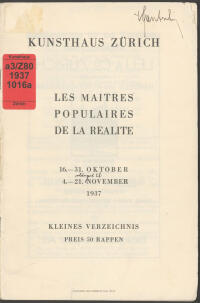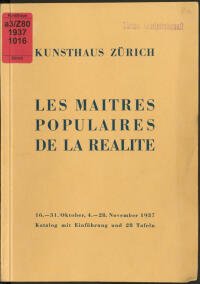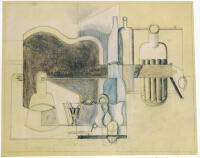Les maîtres populaires de la Réalité. Henri Rousseau, Louis Vivin, Séraphine …
16.10.1937 – 28.11.1937
Location Kunsthaus.
Location Kunsthaus.
The Charm of the Untutored
Full title
Les maîtres populaires de la Réalité. Henri Rousseau, Louis Vivin, Séraphine Louis, Dominique-Paul Peyronnet, André Bauchant, Maurice Utrillo, Camille Bombois, René Rimbert, Jean Eve, dazu Adolf Dietrich und Niklaus Stoecklin‘Les Maîtres populaires de la réalité’ was the title of a group exhibition in 1937. It was based on another in Paris in the previous year, organized by the Musée de Grenoble, where a group of French ‘naïves’ without training in art was to be seen. The Kunsthaus presented about 180 paintings by eight French ‘folkloric masters of reality.’ They included the autodidact Henri Rousseau (1844–1910), but also Maurice Utrillo (1883–1955) and Séraphine Louis (a.k.a Séraphine de Senlis, 1864–1942), the only woman in the group. These artists had in common that they were employed in other jobs: ‘Le Douanier’ Rousseau, as is well known, was a customs officer, Utrillo for a short time as a bank clerk, others as bookkeepers, not a few as technical draftsmen and -women. In the exhibition: the Thurgauer Adolf Dietrich (1877–1957) and the Basler, Niklas Stoecklin (1896–1982), who is known as the main representative of Swiss New Objectivity. Since Stoecklin had been trained at the School of Arts and Crafts in Basel, he is actually an exception in the exhibition.
As a binding component in the show, Kunsthaus-Director Wartmann pointed to the ‘self-created language,’ which distinguished the artists. He also emphasized that that he did not view folkloric art as ‘naïve’ or ‘primitive’ in the sense of imperfect, […] retarded, or deliberately untrained – a thoroughly pleasant, non-colonialist attitude, which is impressive even today. He argued instead for the term ‘naïve’ to be understood in the sense of unselfconscious, and the term ‘primitive’ (today still clearly the more problematic) as original and authentic.
The exhibition was received relatively unenthusiastically. In the NZZ there was pejorative talk of ‘exercises in craftmanship and style,’ which were only exceeded by Rousseau and Stoecklin. In the Luzerner Neuesten Nachrichten the historian Franz Heinemann remarked that these ‘reality artists go so far […] as to overtrump reality and almost to kill it with embarrassingly naïve subtleness.’ Although individual artists were reviewed very positively in the Tages-Anzeiger, here again an unfriendly, patronizing tone goes through the article: ‘We are touched by the hardworking conscientiousness, which comes to our awareness through courageous moments of clumsiness.’
A catalogue appeared with the exhibition, including a longish essay by Wilhelm Wartmann.
[Peter Stohler]
Further information
As a binding component in the show, Kunsthaus-Director Wartmann pointed to the ‘self-created language,’ which distinguished the artists. He also emphasized that that he did not view folkloric art as ‘naïve’ or ‘primitive’ in the sense of imperfect, […] retarded, or deliberately untrained – a thoroughly pleasant, non-colonialist attitude, which is impressive even today. He argued instead for the term ‘naïve’ to be understood in the sense of unselfconscious, and the term ‘primitive’ (today still clearly the more problematic) as original and authentic.

1/2
exhibition catalog

2/2
exhibition catalog
1/2
